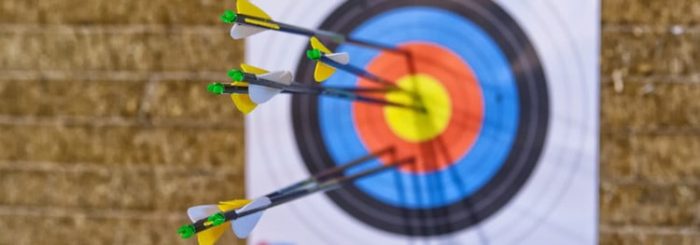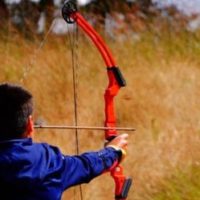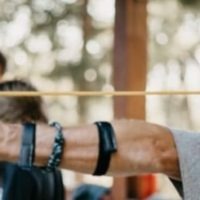Every archer out there is working towards the same goal: increasing their shooting precision. But there are so many things to focus on, including how you perform the shot, your gear itself and your mental headspace. In this post, I’m going to share my top tips to improve your archery accuracy so you can hit a bullseye in no time!
1. Check your stance
Your shooting form might be the thing you should focus most on when practicing archery. Proper posture will allow you to easily draw heavier weight, to have an easier time aiming and to be way more consistent with your shots.
One of the best tricks to check your posture without having someone look at how you perform the shot is to film yourself. You can place your phone so you see your entire body and perform the shot. Don’t look at the phone while taking the shot itself – because you might not perform the shot the same as you would without the immediate feedback. Later look at the video and keep mental notes on what to focus on next. I suggest doing this often until you’re certain your archery stance is good.
If you have a buddy or an archery teacher, you can have them look and critique your stance. This is beneficial because there might be things that are easier for another person to see, or things you think you’re doing correctly but can actually do better.
A thing most people overlook regarding their stance is footing. Your feet are what keeps your grounded and balanced, so it’s really important that you make sure you feel are correctly planted in the ground. The best trick to always remember to check your footing is to focus on your footing and plant your feet in the ground before performing the shot. Try to keep your feet at least shoulder-width apart so you’ll stay balanced during the shot.
Note that small details in how you perform the shot can make a significant impact on how accurate and consistent you are. Don’t downplay imperfection in your form. Some changes might feel unnatural to you at first, because you got used to the wrong stance, but after practicing good posture for a while you’ll notice an improvement.
2. Are you properly anchoring?
After you draw the bowstring, you’ll anchor your hand against the side of your face. Comfortable anchor positions differ for different archers, but what’s important is that your eye is properly aligned with the string. This will allow you to have the best viewpoint for aiming.
Most finger shooters use the hand-to-jaw anchor method, where their index finger is placed a bit below the corner of the mouth or against it, and their thumb located under the chin. Another common anchor point is the nose-to-bowstring, where the tip of their nose touches the bowstring. Release aid users typically place it against their chin for an anchor.
It doesn’t really matter what anchor point you choose to use. What’s important is you use one, and use it consistently. The main idea of having an anchor point is that you pull the string to the exact same place every time you pull the bow. This will enable you to have extremely consistent shooting, which will then translate to better grouping.
3. Stay consistent
Consistency is really important when practicing archery. If you perform the shot exactly the same every time you shoot, you’ll have incredibly tight groupings. But to shoot consistently you have to practice with the same settings.
What I mean is that after finding the sweet spot of bow settings, you should keep practicing with making absolutely minimal changes. So keep training with the same draw length, draw weight and the same types of arrows. (spoiler alert) In tip #8 we’ll discuss what these setting should actually be, but for now, have in mind that staying with a constant draw length and draw weight is a priority.
Let me back up a bit and focus on your arrows. Always have only one kind of arrows in your quiver. This includes the arrow’s weight, length, spine, and fletching. If you have multiple kinds of arrows in the same quiver, your grouping will suffer. I’ll go as far as suggesting you should only shoot one kind of arrows for multiple training sessions because you want to get a rhythm going and get used to how you shoot the specific kind of arrows.
4. Are you following through?
Most archers find it challenging to follow through with their shots. This means they lower their bow too early to see where their arrow hit. I mean, it’s only natural to want to see whether or not you hit the target. But not following through can hurt your score badly, because even though you might aim your shot accurately, if you move the bow at the last second, your arrow will not hit the target.
What experienced archers do is perform the shot, then keep aiming until their arrow actually hit the target. You should keep your bow up and try not to react to the bow going off until you hear the arrow hitting the target. Following this tip will help you be much more accurate with your shot.
5. Relax that bow grip!
It might be counter-intuitive if you’re new to archery, but your bow grip should be gentle and relaxed. I’d go as far as saying that the bow should gently rest in the hand, and you should have minimal contact with it. Most beginner archers clench the bow and hold it as their lives depend on it. I mean, it makes sense – they’re holding a weapon and trying to aim it, and are probably afraid to accidentally let go of the bow.
But when the muscles around your hand – your fingers, forearms, and wrist, are tense, they begin to shake. This makes it almost impossible to accurately aim because these movements go through to the bow. If you want to see that for yourself, just grab an item near you and see how your hands are starting to shake. This doesn’t happen when your muscles are relaxed.
Take a mental note to notice your grip next time you’re practicing. If you catch yourself holding too tightly to the bow, try and relax your grip. This awareness alone can help you achieve better shooting habits and significantly improve your precision quickly.
6. Proper form is not obvious
Shooting a bow seems pretty simple, but it’s really not. Many beginner archers develop bad habits by shooting with incorrect form, which is really hard to get rid of. That’s why I suggest you focus on your form from the start.
The best way to learn proper archery form is going to a professional coach or getting advice from an experienced archer. While it might be beneficial for more experienced archers to tune their form, it’s more important for you as a beginner to have a good start and train with someone who can embed good habits in you.
I also suggest watching a lot of instructional videos and watch how professional archers perform their shots. Focus on the details, like how long does it take them to take the shot, how they’re anchoring and how their feet are positioned. It might show you small ways you can improve your form.
To perfect your form you’ll have to practice really often. Even if you’re taking professional archery lessons, they don’t replace your training. The more you’ll train, the more muscle memory you’ll build and the better your overall form will get.
7. Notice that breathing
When we’re focused on some activity it feels natural to hold our breath, mainly because we feel more focused. But aiming takes time, and not getting the oxygen you need can really affect your aim. Counter-intuitively, holding your breath with full lungs makes you less stable than breathing normally, so it also makes your shots less precise.
If you’ve seen people take aim with a rifle in the movie, or tried shooting at a range yourself, you’ve seen this before. The rifleman takes a breath, lets it go while aiming, and then shoots with empty lungs. The reason they do that is that with empty lungs you’re both still and stable, unlike heavy breathing or holding a deep breath.
As an archer, it’s less important to have empty lungs than for rifle shooter laying on the ground, because your stability changes less than for someone on their stomach. That’s why I suggest either shooting with normal breathing or empty lungs (after taking a big breath and aiming) – you’ll both have enough oxygen and be more stable.
8. Have a proper draw length and draw weight
There’s a mistake every archer eventually does: shooting the wrong bow settings. If you try and shoot with a draw weight you can’t support, or a draw length that doesn’t fit you, you wouldn’t be able to keep good shooting form. This will definitely ruin your accuracy.
It’s important that if you’re a beginner archer you won’t shoot the bow without setting it up and tune it to fit your needs first. If you’re more experienced, don’t let ego control you and only have settings that fit your current strength and skill level.
Figuring out what draw weight you should shoot and adjust your bow accordingly is really easy. If you’re not sure how to do just that, I wrote about it in a previous post, and even explained what your draw weight should probably be. Shooting a higher draw weight than you’re supposed to will wreck your shooting form. It’s better to shoot a low draw weight than a high one.
Your draw length is essential as well. You should tune your bow so it fits your needs. If your bow’s draw length is set too high, you won’t be able to hit the back wall and properly anchor at the correct position. It’s better to have a low draw length setting than a high one. Read more about finding your ideal draw length in my post.
To find your ideal draw length setting, stand straight and lift your arms in a T position. Take the length between the tip of your left middle finger to the tip of the right one, and divide it by 2.5. That’s your ideal draw length.
Shooting with proper draw length and bow weight will enable you to shoot with proper form and dramatically increase your precision. Having your gear fit your needs is always important.
9. Keep track of your arrows
Do this right now; take a pen and number your arrows by writing a small number on them. When practicing, keep track of your progress by writing down your shooting scores, but also keep track of which arrows hit where. Do this for a few weeks and you’ll have a lot of lists in your notebook.
If you see that some arrows consistently miss the aiming point, consider throwing them away. An arrow that misses a lot is most likely damaged or defected.
Even if your arrows are brand new, sometimes issues at the factory cause damaged arrows to be shipped to customers. Other times, just by being stored arrows become defected.
It’s worthwhile to throw away a few arrows if your overall score is affected by them. You want your gear to be in top shape, and damaged arrows don’t serve the purpose you got the for. This can be surprisingly important, especially if you’re a bit more experienced.
10. Slow and steady wins the race
It’s really common for more experienced archers to develop the bad habit of releasing their shots too quickly. It sometimes happens because they get used to their shooting routine, or because they’re simply impatient.
Beginner archers develop a different bad habit of timing their shots, by letting their sight float around the target and hitting the trigger when the pin is above the bullseye. It helps with getting first success, but it’s a bad habit that doesn’t replace proper form.
Both bad habits can be solved by giving yourself time to focus on your shooting form and properly aim. Get used to pull your bow and hold it, while aiming your shots for at least a few seconds. After you’ve aiming and made sure you’re lined up, pull the trigger.
Rushing through aiming and timing the shot without properly aiming are caused by different things and at different skill levels. By learning (or re-learning) to go slow and strictly perform your shots you’ll avoid both.
11. Create a shooting cadence
Your shooting flow is really important because it allows you to get in the zone quickly and focus on the target, knowing that everything else is taken care of. You should aim to have the same routine every time you shoot. After a while, you’ll feel more natural the moment you start your shooting sequence.
Standard shooting cadence includes planting your feet in the ground, fixing your stance, fixing your grip, grabbing an arrow, breathing, drawing the bow, anchoring, breathing again, aiming, shooting and following through. Find the shooting cadence that works best for you and practice it religiously.
By developing a shooting routine you’ll never forget important aspects of your shooting form but also get into the headspace of archery shooting. Many sports practitioners have small things they do before performing, and it really helps with the overall performance. I recommend you do the same.
12. Stretch and warm-up
It’s really important to stretch and warm-up before practicing. Your muscles get really tense by your daily work, which limits your ability to perform. Archers who don’t warm-up before a shoot risk injury and hinder their own progress.
I suggest doing some mobile stretches right before a shoot to warm your muscles up and release your joints. Focus on areas you’re going to use while training, like your back and arms, but don’t leave other parts of your body out. By doing mobile stretches you’ll feel ready for the shoot and lower the chances of injury.
Another thing I really recommend you do is to stretch your muscles on your off days. These should be static stretches that are designed to release tension in your muscles and enable you to have a full range of motion when shooting. For example, stretching your chest muscles, who typically get really tense by your day to day routine, will allow you to open up more when drawing the bow and have way better shooting form.
By stretching and warming-up before shooting and on your off days you’ll improve your ability to shoot with proper form and lower the risk of injury. This will quickly translate into better accuracy.
13. Master the mental game
The headspace your in while practicing archery really affects your performance. It’s both true for training and practicing for fun and for shooting in archery tournaments. It doesn’t matter how much time you spent preparing, tuning your bow and keeping yourself in peak physical conditions, if you’re not in the correct mental space, you won’t be able to perform when you need to.
Like for many other sports, confidence is essential for your success in archery. When you’re training, your goal is to hone your skills and learn different aspects of how to shoot, but also to learn to believe in your capabilities. If you hit bullseye a thousand times before, you’ll definitely believe that you’re able to do it again.
Many archers specifically train their mental headspace using visualizations and affirmations. These are exercises where you visualize success and how it feels, and repeatedly tell yourself that you’re able to achieve it. Personally I don’t like these exercises and I believe you can learn to trust your skills without them, but many people find them valuable.
I think the best way to achieve a perfect mental game is to accept how you feel, no matter what, but without taking it too seriously. If you feel like you’re going to miss your next shot, don’t try to force a different feeling. Just accept that that’s how you feel, laugh it out and perform the best you can. By accepting how you feel you won’t pressure yourself, and by not taking it seriously you won’t let it have power on you. Perfect.
By following the tips in this post, you’ll be able to dramatically improve your shooting precision. I really hope you learned something new today!



